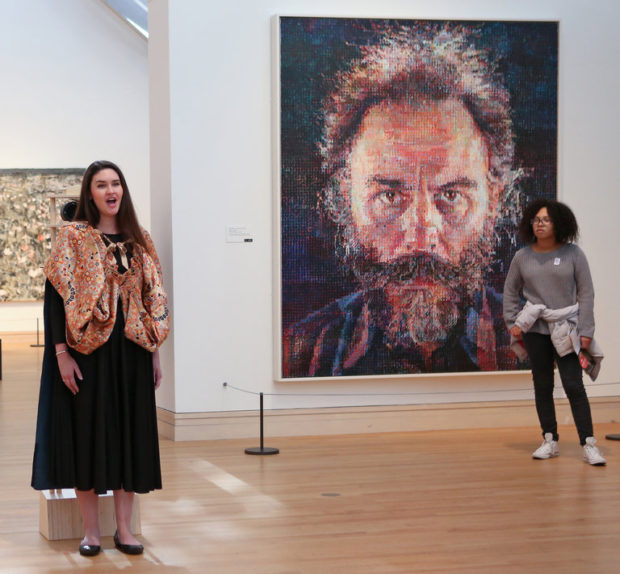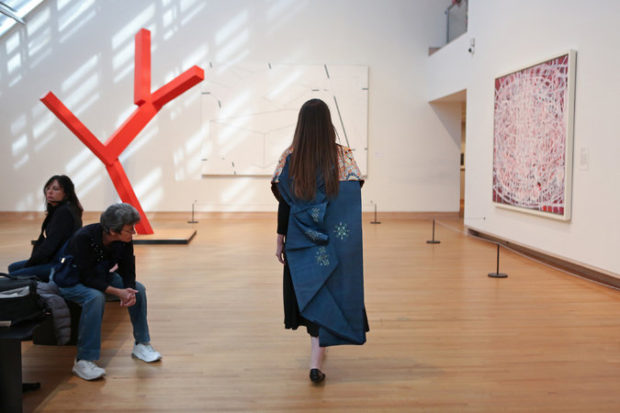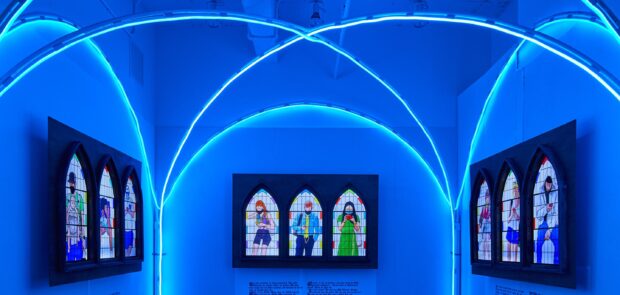A soprano’s voice echoes through the museum’s quiet halls. Inside the Metropolitan’s main gallery for contemporary art, the singer stands before a large, rapt audience but performs only for one. Moments earlier, she approached an unsuspecting viewer with an offer of the “gift of song”; now accepted, the soprano delivers a moving rendition of a Franz Schubert lied—a short operatic solo derived from German poetry of the late 18th and early 19th centuries—to the chosen visitor seated several yards away. In deference to the intimacy of the performance, onlookers quietly move towards the periphery of the gallery. The visitor, seemingly lost in the soprano’s stirring song, begins to cry. After three brief minutes the lied ends and the palpable bond between performer and visitor is broken. What remains, however, is the memory of an experience that transcended mere recital or performance art to strive for something deeper and more consequential: a meaningful, if fleeting, moment of communion between strangers.

Organized through the Metropolitan Museum’s Concerts and Lecture series, this brief exchange was one of many—each incorporating new vocalists, audiences and one of five different lieder—enacted over the course of ten days in November 2015 as part of Lee Mingwei’s performance art piece Sonic Blossom. The work has been presented several times before, including at museums in Korea, Japan, China, Singapore and, most recently, in the United States at the Museum of Fine Arts, Boston. Yet it strikes a particular cord in New York, a city known for its skepticism, impatience and toughness. New Yorkers have learned from experience to be wary of those approaching them wearing odd clothing with promises of ‘gifts’. Staged elsewhere in Manhattan, say in a local park or subway terminal, the performer would have been met with considerable distrust. But in the cultural setting of the Metropolitan, the only museum in the city to house both a fine art and musical instrument collection, visitors are primed for just this kind of unusual artistic behavior.
The territory covered by Sonic Blossom, loosely grouped under the rubric of “social conceptualism”, has been well traversed by other artists, most notably Rikrit Tiravanija and Tino Sehgal, through similarly performative displays of generosity, fellowship and communication with the public. Unlike such projects, however, Lee’s work presents a compelling admixture of personal, sociological and art historical reference points that equally universalize and privatize the scenarios he creates. At the Metropolitan, this manifests itself in cross-cultural and cross-temporal touchstones befitting the museum’s encyclopedic range; the way Sonic Blossom coalesces influences from Asian costume design, European music, German literature and global conceptualism suggests Lee aspires to a collective, transhistoric artistic experience. Simultaneously, however, the work carries intensely idiosyncratic points of reference. Schubert’s lieder, featuring moving lyrics about the noble yet fleeting nature of life, proved especially inspirational to Lee as he cared for his ailing elderly mother. He later decided to honor the profound personal impact of this music by providing viewers with their own immediate, emotionally charged encounter of it. Lee’s artistic interest in love, memory and grief harkens back to the romantic ideals 19th century opera or academic painting. Incorporated into the often sterilized world of contemporary conceptual art, this approach appears refreshingly inventive, rather than retrograde.

Overall, Sonic Blossom performs a delicate tightrope walk between the opposing poles of public and private experience. Though set in a civic space filled with visitors, the performance only directly engages a single person. Consequently, it reflects a fundamental fact about human experience: the moments of greatest significance in our life—occasions of celebration, mourning, triumph and adversity—are the most conventional. Countless others have encountered near identical situations in the past but any given episode feels fresh and meaningful because it is happening to us and it is happening right now. Sonic Blossom embodies this truth by harnessing the affective power of classical music, which has been scientifically proven to heighten our emotional reaction to visual stimuli, to its fullest extent. The result is an affective communion between two people rarely witnessed in our hectic everyday lives.
Despite its stirring result, Sonic Blossom begs a vital question: is this interpersonal connection real or manufactured? Is it just an emotional shortcut, employed by Lee and others, to overcome our increasingly desensitized and mediated digital world? In 2013 Janet Cardiff installed her work Forty Part Motet in a chapel at the Metropolitan’s medieval art outpost, the Cloisters. It, too, utilized classical music to communicate a sense of shared humanity, albeit through recordings played on speakers set up throughout the gallery. Several years earlier, at MoMA, Marina Abramović spent 750 hours across a table from thousands of museum visitors as part of her project The Artist is Present. Many wept, others smiled, still more looked on impatiently as they awaited their own turn in line. Yet, despite their active engagement of the public, Cardiff and Abramović’s projects each remained fettered by barriers that separate performer and viewer, whether technological (Cardiff’s speakers) or personality-driven (Abramović’s fame).
Of course Lee’s own projects, which critic Holland Cotter has termed “hospitality art,” are also constructed. Throughout his entire career Lee has cultivated scenarios to spark optimal engagement between visitor and performer while remaining himself involved solely on a conceptual level. Sonic Blossom, in particular, was meticulously staged from afar; Lee selected the music, hired singers to perform it, dressed them in costume and sent them to a particular gallery in the Met during a specific period of time. These facts suggest Sonic Blossom serves as a performance of intimacy contrived by an omniscient artist. But does that matter? Our lives are full of manufactured experiences that nonetheless affect us deeply. The arts—including theater, cinema and painting, to name a few—are predicated on it. As viewers we maintain the agency to engage or withdraw, a right reflected in the fact that Sonic Blossom visitors were able to refuse the singer’s offer of song. In the end, then, Sonic Blossom may be less a construct of intimacy than its contract. And it is up to the viewer to sign it.






Be First to Comment